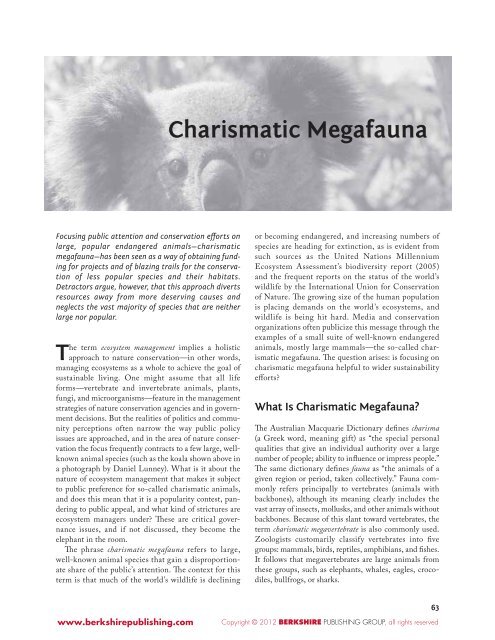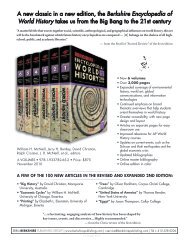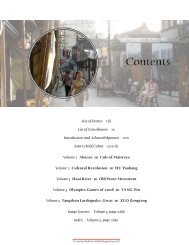Charismatic Megafauna - Berkshire Publishing Group
Charismatic Megafauna - Berkshire Publishing Group
Charismatic Megafauna - Berkshire Publishing Group
Create successful ePaper yourself
Turn your PDF publications into a flip-book with our unique Google optimized e-Paper software.
Focusing public attention and conservation eff orts on<br />
large, popular endangered animals—charismatic<br />
megafauna—has been seen as a way of obtaining funding<br />
for projects and of blazing trails for the conservation<br />
of less popular species and their habitats.<br />
Detractors argue, however, that this approach diverts<br />
resources away from more deserving causes and<br />
neglects the vast majority of species that are neither<br />
large nor popular.<br />
he term ecosystem management implies a holistic<br />
T approach to nature conservation—in other words,<br />
managing ecosystems as a whole to achieve the goal of<br />
sustainable living. One might assume that all life<br />
forms—vertebrate and invertebrate animals, plants,<br />
fungi, and microorganisms—feature in the management<br />
strategies of nature conservation agencies and in government<br />
decisions. But the realities of politics and community<br />
perceptions often narrow the way public policy<br />
issues are approached, and in the area of nature conservation<br />
the focus frequently contracts to a few large, wellknown<br />
animal species (such as the koala shown above in<br />
a photograph by Daniel Lunney). What is it about the<br />
nature of ecosystem management that makes it subject<br />
to public preference for so-called charismatic animals,<br />
and does this mean that it is a popularity contest, pandering<br />
to public appeal, and what kind of strictures are<br />
ecosystem managers under? Th ese are critical governance<br />
issues, and if not discussed, they become the<br />
elephant in the room.<br />
Th e phrase charismatic megafauna refers to large,<br />
well-known animal species that gain a disproportionate<br />
share of the public’s attention. Th e context for this<br />
term is that much of the world’s wildlife is declining<br />
www.berkshirepublishing.com<br />
<strong>Charismatic</strong> <strong>Megafauna</strong><br />
or becoming endangered, and increasing numbers of<br />
species are heading for extinction, as is evident from<br />
such sources as the United Nations Millennium<br />
Ecosystem Assessment’s biodiversity report (2005)<br />
and the frequent reports on the status of the world’s<br />
wildlife by the International Union for Conservation<br />
of Nature. Th e growing size of the human population<br />
is placing demands on the world’s ecosystems, and<br />
wildlife is being hit hard. Media and conservation<br />
organizations often publicize this message through the<br />
examples of a small suite of well-known endangered<br />
animals, mostly large mammals—the so-called charismatic<br />
megafauna. Th e question arises: is focusing on<br />
charismatic megafauna helpful to wider sustainability<br />
eff orts?<br />
What Is <strong>Charismatic</strong> <strong>Megafauna</strong>?<br />
Th e Australian Macquarie Dictionary defi nes charisma<br />
(a Greek word, meaning gift) as “the special personal<br />
qualities that give an individual authority over a large<br />
number of people; ability to infl uence or impress people.”<br />
Th e same dictionary defi nes fauna as “the animals of a<br />
given region or period, taken collectively.” Fauna commonly<br />
refers principally to vertebrates (animals with<br />
backbones), although its meaning clearly includes the<br />
vast array of insects, mollusks, and other animals without<br />
backbones. Because of this slant toward vertebrates, the<br />
term charismatic megavertebrate is also commonly used.<br />
Zoologists customarily classify vertebrates into fi ve<br />
groups: mammals, birds, reptiles, amphibians, and fi shes.<br />
It follows that megavertebrates are large animals from<br />
these groups, such as elephants, whales, eagles, crocodiles,<br />
bullfrogs, or sharks.<br />
Copyright © 2012 <strong>Berkshire</strong> <strong>Publishing</strong> grouP, all rights reserved<br />
63
64 • THE BERKSHIRE ENCYCLOPEDIA OF SUSTAINABILITY: ECOSYSTEM MANAGEMENT AND SUSTAINABILITY<br />
Big, Popular Mammals<br />
An early reference to charismatic megavertebrates<br />
appears in “Saving ‘<strong>Charismatic</strong>’ Animals,” an article<br />
published in the 22 April 1985 issue of Newsweek magazine.<br />
It both defi nes the concept, with examples, and<br />
presents a case for its use by one of the world’s leading<br />
conservation biologists, Edward O. Wilson. Wilson’s<br />
specialty is the study of ants, and thus his support for the<br />
concept lends extra weight in those zoological circles that<br />
complain that popular vertebrates steal the limelight in<br />
the conservation debate.<br />
Th e latest tactic acknowledges that public support<br />
cannot be mobilized to save the snake mite—or<br />
thousands of other homely beasts. Instead, within<br />
the past year many wildlife conservationists have<br />
forged a policy of preserving and promoting “charismatic<br />
megavertebrates,” the pandas, tigers, okapis<br />
and other glamorous rarities that rivet public sentiment.<br />
If this is a rude repudiation of the conservation<br />
purist’s all-or-nothing creed, it’s also a deftly<br />
plotted political practicality. “Th ere is a sense of<br />
mission now, and of encouragement,” says eminent<br />
Harvard zoologist Edward O. Wilson. “Our most<br />
easily appreciated species can call attention to the<br />
plight of our entire ecosystem.” (“Saving ‘<strong>Charismatic</strong>’<br />
Animals,” 10)<br />
In this application of the strategy, the charismatic<br />
megafauna are employed for the conservation benefi t of<br />
all other species and, in fact, entire ecosystems.<br />
Environmental problems, such as habitat loss and fragmentation,<br />
pollution, introduced species, and climate<br />
change impacts, aff ect all species. <strong>Charismatic</strong> animals<br />
allow us to publicize these generic sustainability issues<br />
and to explore, with popular support, ways of countering<br />
their eff ects, to the benefi t of all wildlife that suff er the<br />
same problems and utilize the same geographical areas.<br />
Furthermore, protecting popular species and their habitats<br />
helps us conserve a habitat network across landscapes,<br />
to the benefi t of all fauna. Th e conservation<br />
zoologist Norman Myers (1996) points out that once<br />
large vertebrate species are lost, the opportunities for new<br />
large vertebrate species to evolve will also be lost in a<br />
planet much modifi ed by human activities.<br />
Th e Newsweek article names three species, describing<br />
them as “glamorous rarities.” Th e panda is arguably the<br />
best-known glamorous rarity, a pin-up charismatic megavertebrate.<br />
In a 1998 editorial in the journal Oryx , Jacqui<br />
Morris observes that mammals make up a relatively small<br />
proportion of the world’s fauna, yet over the previous<br />
decade, half of the papers published in Oryx had mammals<br />
as their primary focus. Morris notes that, in the<br />
www.berkshirepublishing.com<br />
opening paper of that 1998 edition of Oryx , Jeff rey<br />
McNeely makes a plea to fi nd new ways of conserving<br />
mammals beyond research, survey, and anti-poaching,<br />
saying that mammal conservationists need to tackle<br />
underlying issues such as habitat destruction, overexploitation,<br />
and introduced species. Morris thus points to the<br />
tension of highlighting individual species versus addressing<br />
root causes.<br />
Th is theme became the subject of a book by Abigail<br />
Entwistle and Nigel Dunstone, Priorities for the<br />
Conservation of Mammalian Diversity—Has the Panda<br />
Had Its Day? (2000). Th e book notes that, since r ecent<br />
analyses have shown that about a quarter of all mammal<br />
species are threatened with extinction, the conservation<br />
movement is moving rapidly away from a traditional<br />
“protectionist” approach to nature toward a more<br />
integrated view of wildlife and landscape conservation.<br />
Th e British magazine Th e Economist ran an article on<br />
7 January 2008 entitled “Branding Land: Conservation<br />
Marketers Choose Land over Beast,” which makes the<br />
point that although conservation organizations have long<br />
understood the fund- raising value of charismatic megafauna,<br />
the money raised to save these animals often cannot<br />
be spent on broader conservation goals. Th e article<br />
discusses an alternative response adopted by the<br />
Zoological Society of London, which is to focus on<br />
“evolutionarily distinct and globally endangered”<br />
(EDGE) species. Th ese species, the article notes, are<br />
“rarely cuddly” and may “look quite weird,” but they are<br />
often the last representative of an entire animal group.<br />
EDGE species—which include the duck-billed platypus,<br />
the long-beaked echidna, the aardvark, and the dugong—<br />
may not be considered endangered, but it can be argued<br />
that because they are rare from an evolutionary standpoint,<br />
conservation action should be undertaken before<br />
they become endangered.<br />
All Creatures Great and Small<br />
While the public presses for iconic species to be protected,<br />
government resources are often narrowly<br />
focused on threatened species for research and conservation<br />
eff ort, to the neglect of the far greater number of<br />
species that are not listed as threatened. It is important<br />
for managers working to maintain biodiversity to have<br />
statistically workable numbers to determine the impacts<br />
of change, such as from logging, fi re, and climate<br />
change. Th e animals that provide the most eff ective<br />
answers are the common species, and often the least<br />
charismatic, such as native bush rats. Few people are<br />
keen to hear about the ecology of rats, even though<br />
they provide insights for conservation of certain ecosystems,<br />
such as forests or riparian strips (riverbank<br />
Copyright © 2012 <strong>Berkshire</strong> <strong>Publishing</strong> grouP, all rights reserved
habitats), which rare animals never can. In contrast, an<br />
investigation on the remediation of rural lands for<br />
koala conservation was given detailed television coverage<br />
in Australia on 14 April 2011, when the recovery of<br />
the koala population was set back sharply by climate<br />
change (Lunney et al. 2012). Th e native rats would not<br />
have gained the coverage, and they do not attract the<br />
funding dollars.<br />
Th e article in Th e Economist (“Branding Land” 2008)<br />
notes the value of so-called fl agship areas—that is, entire<br />
regions identifi ed as threatened and<br />
worthy of protection. For example,<br />
Conservation International,<br />
based in Arlington, Virginia,<br />
has designated a number of<br />
fl agship areas, including the<br />
tropical Andes, the Brazilian<br />
Atlantic forests, and Africa’s<br />
Cape fl oristic region. Th e World<br />
Wide Fund for Nature, based<br />
in Gland, Switzerland, has also<br />
identifi ed what it calls “global<br />
ecoregions.” Money raised as a<br />
result of designating fl agship areas<br />
can be used for a variety of conversation<br />
projects, not just to protect<br />
certain well-known species.<br />
What about conservation of the<br />
small animals? Th e vast majority of<br />
animals are invertebrates, and their<br />
contribution to ecosystem function<br />
overwhelms the contribution<br />
of the vertebrates.<br />
With a few exceptions,<br />
such as the<br />
octopus, invertebrates<br />
are not megafauna,<br />
but many are charismatic.<br />
Butterflies are<br />
one example; coral reefs<br />
are another. Despite a long<br />
list of engaging animals, the<br />
invertebrates languish in attracting public<br />
attention. So incensed was the Australian Museum<br />
mollusk expert Winston Ponder that he wrote a paper<br />
entitled “Bias and Biodiversity” (1992) and coedited a<br />
large book on the biology and conservation of invertebrates<br />
entitled Th e Other 99% (1999) . Invertebrates are<br />
now commonly referred to as “the other 99 percent.”<br />
Even within the vertebrates, the large charismatic<br />
species are an insignifi cant minority. Th e two mammal<br />
orders with the most species are the rodents and the<br />
bats, but fi nding charismatic rats or bats is at best a<br />
matter of individual taste. Th e beaver qualifi es as a<br />
www.berkshirepublishing.com<br />
CHARISMATIC MEGAFAUNA • 65<br />
charismatic rodent, but most beavers look like the<br />
despised rats and mice. Flying foxes are large fruit-<br />
eating bats, with wingspans up to a meter when in fl ight.<br />
Th ey are utterly captivating to some people, but they are<br />
also problematic to propose as charismatic to a broad<br />
public. Th ey induce fear in some people because they are<br />
bats, and in their vast camps they are seen by some as<br />
pests, particularly so when they raid orchards. Th e<br />
worry that they potentially carry lethal diseases has further<br />
tarnished their image. Public ignorance and fear of<br />
bats reaches back two thousand years (Lunney<br />
and Moon 2011).<br />
Implications<br />
From this overview of<br />
charismatic megafauna,<br />
the conclusion can be<br />
drawn that the term is about<br />
capitalizing on the preexisting<br />
views of the public about their<br />
concept of “fauna,” which<br />
animals they like, and where<br />
people are willing to assist<br />
conservation programs<br />
aimed at conserving nature.<br />
Does a focus on a few highprofi<br />
le species reinforce an<br />
already constrained agenda<br />
for those who work to conserve<br />
the diversity of species<br />
and the ecosystems of which<br />
they are vital elements? It<br />
does, but it also facilitates<br />
conservation gains. Given<br />
the multitude of pressures on<br />
ecosystems and their faunal<br />
inhabitants through the<br />
twentieth century, it is fair<br />
to say that all conservation<br />
gains are welcome. Th ere<br />
has been a phenomenal growth<br />
in fauna conservation eff orts in<br />
the last four decades, and the rate of loss<br />
of biodiversity has been slowed in many places. Th at<br />
is a great achievement considering the path that<br />
humanity had been on, and a new generation now has<br />
the challenge of reversing these losses, fortunately<br />
with most of the charismatic megavertebrates still here<br />
to enjoy.<br />
Daniel LUNNEY<br />
Offi ce of Environment and Heritage NSW, Australia<br />
Copyright © 2012 <strong>Berkshire</strong> <strong>Publishing</strong> grouP, all rights reserved
66 • THE BERKSHIRE ENCYCLOPEDIA OF SUSTAINABILITY: ECOSYSTEM MANAGEMENT AND SUSTAINABILITY<br />
See also Biodiversity; Biodiversity Hotspots; Biogeography;<br />
Community Ecology; Complexity Th eory; Ecological<br />
Restoration; Fencing; Food Webs; Habitat Fragmentation;<br />
Hunting; Marine Protected Areas (MPAs); Population<br />
Dynamics; Species Reintroduction<br />
F URTHER READING<br />
Th e Economist . (2008, January 7). Branding land: Conservation marketers<br />
choose land over beast. Retrieved October 15, 2011, from<br />
http://www.economist.com/node/10486391<br />
Entwistle, Abigail, & Dunstone, Nigel. (Eds.). (2000). Priorities for<br />
the conservation of mammalian diversity— Has the panda had its day?<br />
Cambridge, UK: Cambridge University Press.<br />
Law, Brad; Eby, Peggy; Lunney, Daniel; & Lumsden, Lindy. (Eds.).<br />
(2011). Th e biology and conservation of Australasian bats. Mosman,<br />
Australia: Royal Zoological Society of NSW.<br />
Lunney, Daniel; Matthews, Alison; Cogger, Hal; & Dickman, Chris.<br />
(2004). Th e neglected 74%—the non-threatened vertebrates—and<br />
a refl ection on the limitations of the process that fashioned the current<br />
schedules of threatened species in New South Wales. In Pat<br />
Hutchings, Daniel Lunney & Chris Dickman (Eds.), Th reatened<br />
species legislation: Is it just an act? (pp. 145–157). Mosman, Australia:<br />
Royal Zoological Society of NSW.<br />
www.berkshirepublishing.com<br />
Lunney, Daniel, et al. (2012). Koalas and climate change: A case study<br />
on the Liverpool Plains, north-west NSW. In Daniel Lunney &<br />
Pat Hutchings (Eds.), Wildlife and climate change: Towards robust<br />
conservation strategies for Australian fauna. Mosman, Australia:<br />
Royal Zoological Society of NSW.<br />
Lunney, Daniel, & Moon, Chris. (2011). Blind to bats. In Brad Law,<br />
Peggy Eby, Daniel Lunney & Lindy Lumsden (Eds.), Th e biology<br />
and conservation of Australasian bats (pp. 44–63). Mosman,<br />
Australia: Royal Zoological Society of NSW.<br />
Millennium Ecosystem Assessment. (2005). Ecosystems and human<br />
well-being: Biodiversity synthesis. Washington, DC: World<br />
Resources Institute.<br />
Morris, Jacqui. (1998). Has the panda had its day? Oryx, 32 (1), 1.<br />
Myers, Norman. (1996). Th e biodiversity crisis and the future of evolution.<br />
Th e Environmentalist, 16 , 37–47.<br />
Ponder, Winston. (1992). Bias and biodiversity. Australian Zoologist,<br />
28, 47–50.<br />
Ponder, Winston, & Lunney, Daniel. (Eds.). (1999). Th e other 99%: Th e<br />
conservation and biodiversity of invertebrates. Mosman, Australia:<br />
Royal Zoological Society of NSW.<br />
Saving “charismatic” animals. (1985, April 22). Newsweek, 105 (16), 10.<br />
Taylor, Anja (Producer). (2011, 14 April). Koala heatwave. In Catalyst<br />
[Television series episode] . Sydney: Australian Broadcasting<br />
Corporation. Video retrieved October 15, 2011, from http://www.<br />
abc.net.au/catalyst/stories/3191750.htm<br />
Copyright © 2012 <strong>Berkshire</strong> <strong>Publishing</strong> grouP, all rights reserved




